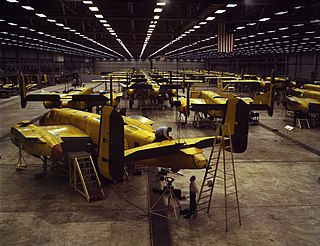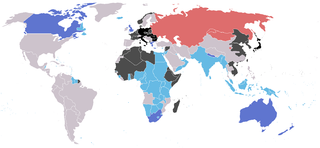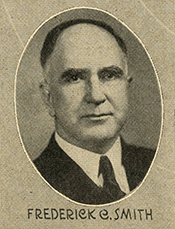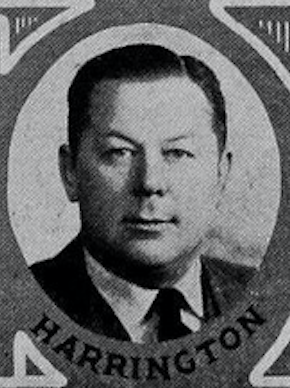The Neutrality Acts were a series of acts passed by the US Congress in 1935, 1936, 1937, and 1939 in response to the growing threats and wars that led to World War II. They were spurred by the growth in isolationism and non-interventionism in the US following the US joining World War I, and they sought to ensure that the US would not become entangled again in foreign conflicts.

Lend-Lease, formally the Lend-Lease Act and introduced as An Act to Promote the Defense of the United States, was a policy under which the United States supplied the United Kingdom, the Soviet Union, France, Republic of China, and other Allied nations of the Second World War with food, oil, and materiel between 1941 and 1945. The aid was given free of charge on the basis that such help was essential for the defense of the United States.
This section of the timeline of United States history concerns events from 1930 to 1949.
A neutral country is a state that is neutral towards belligerents in a specific war or holds itself as permanently neutral in all future conflicts. As a type of non-combatant status, nationals of neutral countries enjoy protection under the law of war from belligerent actions to a greater extent than other non-combatants such as enemy civilians and prisoners of war. Different countries interpret their neutrality differently: some, such as Costa Rica, have demilitarized, while Switzerland holds to "armed neutrality", to deter aggression with a sizeable military, while barring itself from foreign deployment.

The Emergency was a state of emergency in the independent state of Ireland in the Second World War, throughout which the state remained neutral. It was proclaimed by Dáil Éireann on 2 September 1939, allowing the passage of the Emergency Powers Act 1939 by the Oireachtas the following day. This gave sweeping powers to the government, including internment, censorship of the press and correspondence, and control of the economy. The Emergency Powers Act lapsed on 2 September 1946, although the Emergency was not formally ended until 1976.

America's manufacturers in World War II were engaged in the greatest military industrial effort in history. Aircraft companies went from building a handful of planes at a time to building them by the thousands on assembly lines. Aircraft manufacturing went from a distant 41st place among American industries to first place in less than five years.
United States non-interventionism primarily refers to the foreign policy that was eventually applied by the United States between the late 18th century and the first half of the 20th century whereby it sought to avoid alliances with other nations in order to prevent itself from being drawn into wars that were not related to the direct territorial self-defense of the United States. Neutrality and non-interventionism found support among elite and popular opinion in the United States, which varied depending on the international context and the country's interests. At times, the degree and nature of this policy was better known as isolationism, such as the interwar period.

"The Darkest Hour" is a phrase used to refer to an early period of World War II, from approximately mid-1940 to mid-1941. While widely attributed to Winston Churchill, the origins of the phrase are unclear.

The 76th United States Congress was a meeting of the legislative branch of the United States federal government, composed of the United States Senate and the United States House of Representatives. It met in Washington, D.C., from January 3, 1939, to January 3, 1941, during the seventh and eighth years of Franklin D. Roosevelt's presidency. The apportionment of seats in the House of Representatives was based on the 1930 United States census.

The Allies, formally referred to as the United Nations from 1942, were an international military coalition formed during World War II (1939–1945) to oppose the Axis powers. Its principal members by the end of 1941 were the "Big Four" - United Kingdom, United States, Soviet Union, and China.
The Committee to Defend America by Aiding the Allies (CDAAA) was an American mass movement, political action group formed in May 1940. Also known as the White Committee, its leader until January 1941 was William Allen White. Other important members included Clark Eichelberger and Dean Acheson. The CDAAA shared its leadership with the dissolved Non-Partisan Committee for Peace through Revision of the Neutrality Law (NPC), who was also chaired by White and directed by Eichelberger. Additionally, the CDAAA used ex-NPC offices in the League of Nations building at 8 W. Fortieth Street in New York City, as their central base. This has drawn commentators to regard the CDAAA as the successor to the NPC.

War Comes to America is the seventh and final film of Frank Capra's Why We Fight World War II propaganda film series.

"Arsenal of Democracy" was the central phrase used by U.S. President Franklin D. Roosevelt in a radio broadcast on the threat to national security, delivered on December 29, 1940—nearly a year before the United States entered the Second World War (1939–1945). Roosevelt promised to help the United Kingdom fight Nazi Germany by selling them military supplies while the United States stayed out of the actual fighting. The president announced that intent a year before the Attack on Pearl Harbor, at a time when Germany had occupied much of Europe and threatened Britain.

Joseph Lawrence Pfeifer was an American physician and politician who served as a member of the United States House of Representatives for New York's 8th congressional district from 1935 to 1951.

Frederick Cleveland Smith was an American physician and politician who served six terms as a Republican member of the U.S. House of Representatives from Ohio from 1939 to 1951.

Vincent Francis Harrington was a Democratic U.S. Representative from Iowa. Harrington was commissioned in the United States Army Air Forces after the Pearl Harbor attack, resigned from Congress when President Franklin D. Roosevelt disallowed members of Congress from serving in the military at the same time, and died of natural causes while on active duty in England. A Liberty Ship was named in his honor.
The diplomatic history of World War II includes the major foreign policies and interactions inside the opposing coalitions, the Allies of World War II and the Axis powers, between 1939 and 1945.

The first term of the presidency of Franklin D. Roosevelt began on March 4, 1933, when he was inaugurated as the 32nd president of the United States, and the second term of his presidency ended on January 20, 1941, with his inauguration to a third term. Roosevelt, the Democratic governor of the largest state, New York, took office after defeating incumbent President Herbert Hoover, his Republican opponent in the 1932 presidential election. Roosevelt led the implementation of the New Deal, a series of programs designed to provide relief, recovery, and reform to Americans and the American economy during the Great Depression. He also presided over a realignment that made his New Deal Coalition of labor unions, big city machines, white ethnics, African Americans, and rural white Southerners dominant in national politics until the 1960s and defined modern American liberalism.

The third presidential term of Franklin D. Roosevelt began on January 20, 1941, when he was once again inaugurated as the 32nd president of the United States, and the fourth term of his presidency ended with his death on April 12, 1945. Roosevelt won a third term by defeating Republican nominee Wendell Willkie in the 1940 United States presidential election. He remains the only president to serve for more than two terms. Unlike his first two terms, Roosevelt's third and fourth terms were dominated by foreign policy concerns, as the United States became involved in World War II in December 1941.
The foreign policy of the United States was controlled personally by Franklin D. Roosevelt during his first and second and third and fourth terms as the president of the United States from 1933 to 1945. He depended heavily on Henry Morgenthau Jr., Sumner Welles, and Harry Hopkins. Meanwhile, Secretary of State Cordell Hull handled routine matters. Roosevelt was an internationalist, while powerful members of Congress favored more isolationist solutions in order to keep the U.S. out of European wars. There was considerable tension before the Attack on Pearl Harbor in December 1941. The attack converted the isolationists or made them irrelevant. The US began aid to the Soviet Union after Germany invaded it in June 1941. After the US declared war in December 1941, key decisions were made at the highest level by Roosevelt, Britain's Winston Churchill and the Soviet Union's Joseph Stalin, along with their top aides. After 1938 Washington's policy was to help China in its war against Japan, including cutting off money and oil to Japan. While isolationism was powerful regarding Europe, American public and elite opinion strongly opposed Japan.












